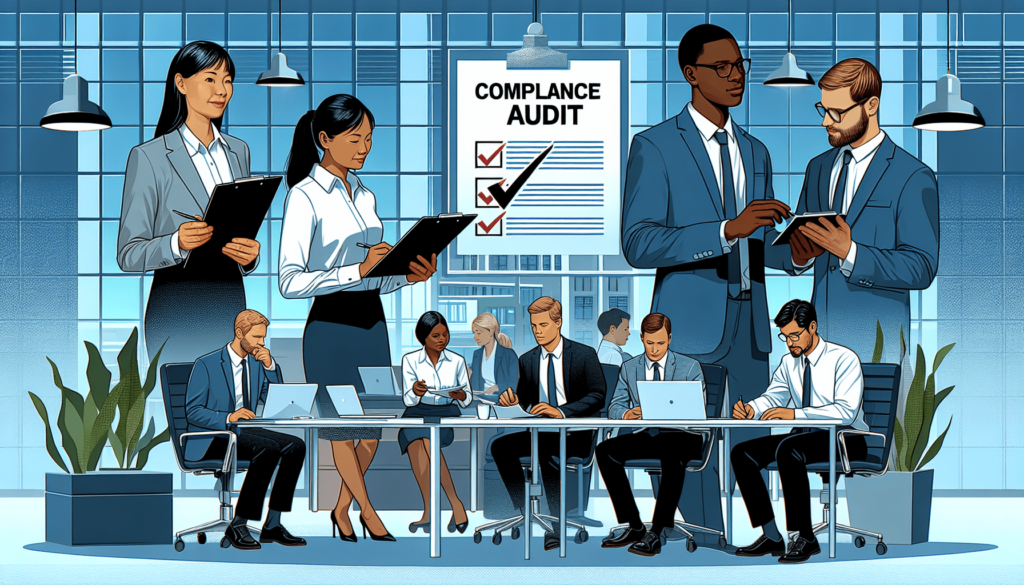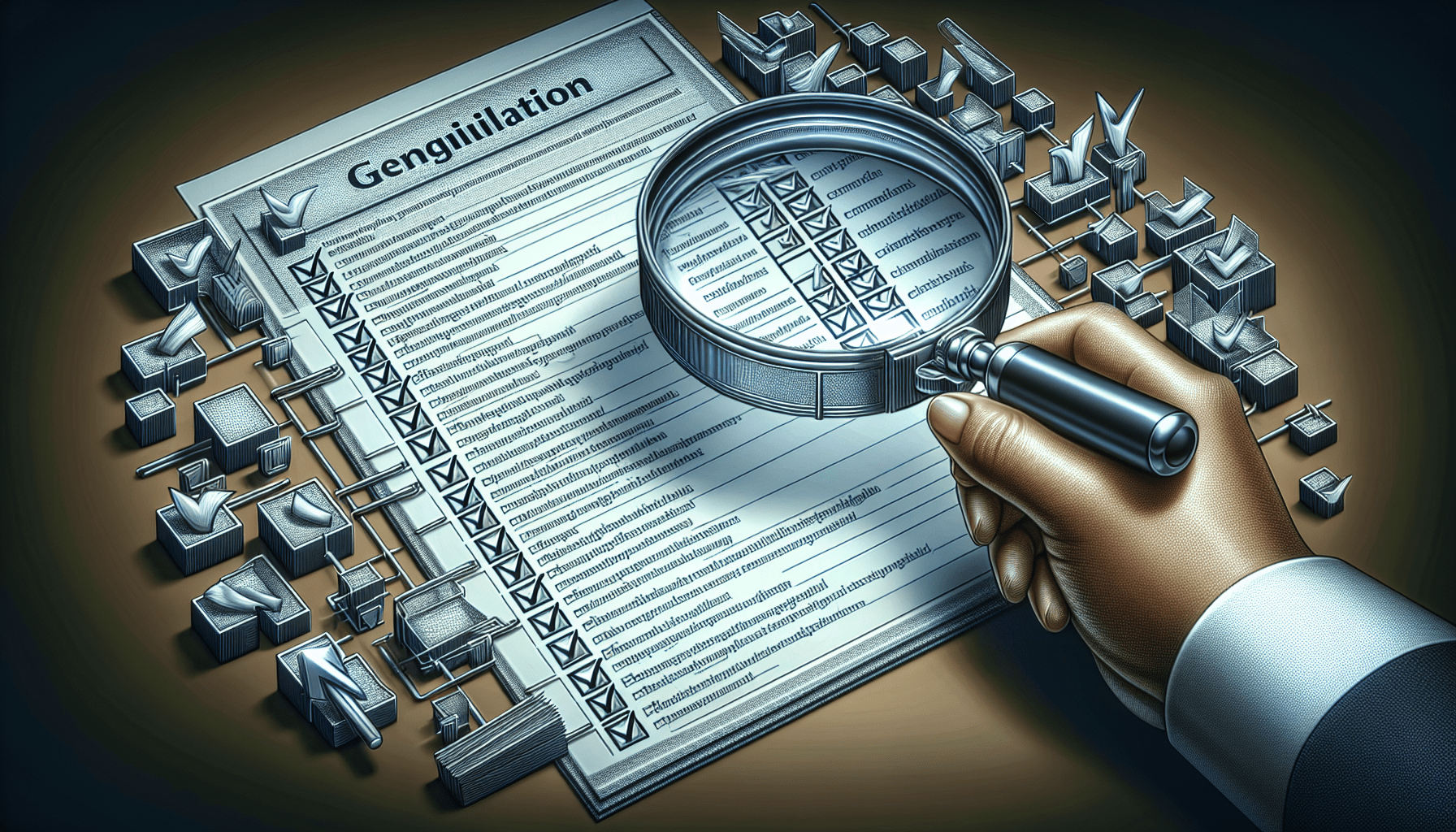In the realm of business, ensuring compliance with regulatory requirements is crucial in maintaining ethical standards and mitigating potential risks. Conducting compliance audits allows organizations to evaluate their adherence to relevant laws and regulations, thus avoiding legal issues and reputational damage. This article explores the best practices for conducting compliance audits, offering valuable insights on how to effectively plan, execute, and report on the findings of such audits. By following these best practices, companies can ensure their operations are in line with the law and maintain a competitive advantage in the industry.

Establishing Objectives
Clearly define the goals and objectives of the compliance audit
When conducting a compliance audit, it is essential to clearly define the goals and objectives of the audit. This involves identifying the specific areas of compliance that will be assessed and the desired outcomes of the audit. By establishing clear objectives, you can ensure that the audit is focused and effective in assessing the organization’s compliance with relevant laws, regulations, and industry standards.
Align the objectives with the organization’s regulatory requirements
To ensure the compliance audit is aligned with the organization’s regulatory requirements, it is crucial to thoroughly understand the relevant laws, regulations, and industry standards that apply to the organization. By aligning the objectives of the audit with these requirements, you can ensure that the assessment is comprehensive and that any potential compliance issues are identified.
Identify areas or processes to be audited
Once the objectives of the compliance audit are established and aligned with regulatory requirements, it is necessary to identify the specific areas or processes within the organization that will be audited. This may include identifying key departments or functions that are subject to compliance requirements or focusing on specific processes or activities that are considered high-risk. By identifying the areas or processes to be audited, you can ensure that the audit is targeted and efficient.
Developing an Audit Plan
Determine the scope of the audit
Before conducting a compliance audit, it is essential to determine the scope of the assessment. This involves defining the boundaries of the audit, including the specific areas, processes, or functions that will be included in the assessment. By clearly defining the scope, you can ensure that the audit is focused and manageable, allowing for a thorough evaluation of the organization’s compliance.
Create a detailed timeline for the audit activities
To ensure that the compliance audit is conducted efficiently, it is important to create a detailed timeline for the audit activities. This timeline should include important milestones, such as the start and end dates of the audit, as well as specific deadlines for completing various audit tasks. By establishing a timeline, you can ensure that the audit stays on track and that the assessment is completed within the desired timeframe.
Allocate necessary resources
Conducting a compliance audit requires the allocation of appropriate resources, including personnel, tools, and technology. It is important to identify the necessary resources and ensure that they are available and properly allocated for the duration of the audit. This may involve assigning qualified auditors to the assessment, providing access to relevant documentation and systems, and obtaining any additional resources needed to support the audit activities.
Define the audit methodology and approach
To conduct a compliance audit effectively, it is important to define the audit methodology and approach. This involves determining the specific methods and techniques that will be used to gather and evaluate evidence, such as interviews, observations, and testing. By defining the audit methodology and approach, you can ensure that the assessment is consistent, rigorous, and aligned with best practices in compliance auditing.
Gathering Documentation
Identify and collect relevant policies, procedures, and guidelines
As part of the compliance audit, it is important to identify and collect relevant policies, procedures, and guidelines that govern the organization’s compliance activities. These documents provide a basis for evaluating the organization’s adherence to applicable laws, regulations, and industry standards. By gathering this documentation, you can ensure that the audit is thorough and that all relevant criteria are considered during the assessment.
Review applicable laws, regulations, and industry standards
In addition to reviewing internal policies and procedures, it is essential to review applicable laws, regulations, and industry standards that apply to the organization. This ensures that the compliance audit takes into account the external requirements that the organization must comply with. By reviewing the relevant laws, regulations, and industry standards, you can verify the organization’s compliance and identify any potential gaps or deficiencies.
Obtain and review previous audit reports or findings
To gain a comprehensive understanding of the organization’s compliance history, it is important to obtain and review any previous audit reports or findings. These reports can provide valuable insights into past compliance issues, the effectiveness of previous corrective actions, and areas of ongoing concern. By reviewing previous audit reports or findings, you can ensure that the current audit builds upon previous assessments and addresses any recurring or unresolved compliance issues.
Conducting Interviews and Observations
Interview key personnel involved in compliance processes
When conducting a compliance audit, it is vital to interview key personnel who are involved in compliance processes within the organization. These individuals may include compliance officers, managers, and employees responsible for implementing and maintaining compliance measures. By interviewing these key personnel, you can gather valuable information about the effectiveness of the compliance processes and identify any potential areas of non-compliance.
Observe the implementation of compliance measures in action
In addition to conducting interviews, it is important to observe the implementation of compliance measures in action. This may involve observing employees carrying out compliance activities, reviewing relevant documentation and records, or assessing the organization’s physical environment for compliance-related factors. By observing the implementation of compliance measures, you can validate the effectiveness of the organization’s processes and detect any potential non-compliance issues.
Document observations and gather evidence
During the compliance audit, it is crucial to document observations and gather evidence to support the findings. This may involve taking detailed notes during interviews and observations, capturing relevant photographs or videos, and requesting and reviewing additional documentation or records. By documenting observations and gathering evidence, you can ensure that the audit findings are based on objective and verifiable information, supporting the accuracy and credibility of the assessment.

Performing Testing and Analysis
Select and apply appropriate testing methods
To assess the accuracy and effectiveness of compliance measures, it is necessary to select and apply appropriate testing methods. This may include conducting sample reviews of documentation or transactions, performing data analysis, or engaging in simulations or scenario testing. By selecting and applying appropriate testing methods, you can measure the organization’s compliance performance, identify any potential discrepancies or anomalies, and evaluate the overall effectiveness of compliance processes.
Analyze data for compliance accuracy and effectiveness
In addition to testing methods, it is important to analyze data for compliance accuracy and effectiveness. This involves reviewing relevant data and information, such as financial records, system logs, or performance metrics, to assess the organization’s compliance performance. By analyzing the data, you can identify trends, patterns, or outliers that may indicate areas of non-compliance or potential weaknesses in the compliance processes.
Identify any gaps or deficiencies in compliance processes
Throughout the testing and analysis phase, it is essential to identify any gaps or deficiencies in the organization’s compliance processes. This includes identifying any areas where the organization may not be fully compliant with applicable laws, regulations, or industry standards or where compliance processes may be ineffective or insufficient. By identifying these gaps or deficiencies, you can provide valuable insights into areas for improvement and help the organization strengthen its compliance practices.
Identifying Non-compliance Issues
Document and categorize identified non-compliance issues
As part of the compliance audit, it is crucial to document and categorize any identified non-compliance issues. This includes clearly documenting the nature of each non-compliance issue, the specific requirements that are not being met, and any potential risks or consequences associated with the non-compliance. By documenting and categorizing the non-compliance issues, you can provide a clear and comprehensive overview of the organization’s compliance performance.
Prioritize the issues based on the level of risk or severity
Once the non-compliance issues have been identified and categorized, it is important to prioritize them based on the level of risk or severity. This involves assessing the potential impact of each non-compliance issue on the organization’s operations, reputation, or legal obligations. By prioritizing the issues, you can ensure that appropriate attention and resources are allocated to address the most critical non-compliance issues first.
Evaluate the root causes of non-compliance
To effectively address non-compliance issues, it is necessary to evaluate the root causes of the non-compliance. This involves identifying the underlying factors, such as cultural, procedural, or systemic issues, that contribute to the non-compliance. By evaluating the root causes, you can develop more targeted and effective corrective actions, addressing the fundamental issues that are responsible for the non-compliance.

Developing Corrective Actions
Propose appropriate corrective measures for each non-compliance issue
Once the non-compliance issues and their root causes have been identified, it is important to propose appropriate corrective measures for each issue. These corrective measures should be designed to address the specific non-compliance issue and mitigate the associated risks. By proposing appropriate corrective measures, you can provide the organization with clear and actionable steps to rectify the non-compliance and prevent its recurrence in the future.
Ensure corrective actions are practical and feasible
When developing corrective actions, it is important to ensure that they are practical and feasible for the organization to implement. This involves considering the organization’s resources, capabilities, and constraints in designing the corrective measures. By ensuring that the corrective actions are practical and feasible, you increase the likelihood of successful implementation and compliance improvement.
Assign responsibilities and create an action plan
To ensure accountability and effective implementation of the corrective actions, it is essential to assign responsibilities and create an action plan. This involves clearly defining the roles and responsibilities of individuals or teams responsible for implementing the corrective measures and establishing a timeline for completion. By assigning responsibilities and creating an action plan, you can facilitate smooth execution and monitoring of the corrective actions.
Tracking and Monitoring Progress
Implement a tracking system to monitor the progress of corrective actions
To effectively manage and monitor the implementation of corrective actions, it is important to implement a tracking system. This system should allow for the documentation and tracking of the progress of each corrective action, including key milestones, deadlines, and any changes or challenges encountered. By implementing a tracking system, you can ensure that the corrective actions are progressing as planned and identify any potential delays or issues that may require attention.
Regularly review and update the status of each corrective action
As the corrective actions are implemented, it is crucial to regularly review and update their status. This involves monitoring the progress, assessing the effectiveness of the measures, and addressing any issues or roadblocks that may arise. By reviewing and updating the status of each corrective action, you can ensure that they remain on track and are achieving the desired outcomes.
Establish reporting mechanisms for ongoing compliance monitoring
To maintain ongoing compliance, it is essential to establish reporting mechanisms for monitoring and reporting on compliance performance. This may involve implementing regular reporting cycles, establishing key performance indicators, or developing dashboards or other tools to track and communicate compliance metrics. By establishing reporting mechanisms, you can ensure ongoing visibility and accountability for compliance performance and facilitate timely identification of any potential compliance issues.

Reporting Findings
Prepare a comprehensive report summarizing the audit findings
Once the compliance audit is completed, it is important to prepare a comprehensive report summarizing the audit findings. This report should provide a clear and concise overview of the key findings, including any non-compliance issues identified, the root causes of the non-compliance, and the proposed corrective actions. By preparing a comprehensive report, you can provide stakeholders with a comprehensive understanding of the organization’s compliance performance and the actions required to improve compliance.
Include recommendations for improvements and remediation
In addition to summarizing the audit findings, the report should include recommendations for improvements and remediation. These recommendations should be based on the identified non-compliance issues and their root causes and should provide clear guidance on the steps required to achieve compliance. By including recommendations for improvements and remediation, you can assist the organization in implementing the necessary changes to enhance compliance performance.
Ensure the report is clear, concise, and easily understandable
When preparing the report, it is crucial to ensure that it is clear, concise, and easily understandable. This involves using plain language, avoiding jargon or technical terms, and organizing the information in a logical and structured manner. By preparing a clear and concise report, you can facilitate effective communication and understanding of the audit findings and recommendations by stakeholders.
Continuous Improvement
Regularly review and update compliance policies and procedures
To ensure ongoing compliance, it is important to regularly review and update compliance policies and procedures. This involves assessing the effectiveness of existing policies and procedures, considering changes in laws or regulations, and incorporating lessons learned from the compliance audit findings. By regularly reviewing and updating compliance policies and procedures, you can adapt to evolving compliance requirements and improve the effectiveness of compliance practices.
Provide ongoing training to employees
In addition to reviewing policies and procedures, it is important to provide ongoing training to employees on compliance requirements and expectations. This training should be tailored to the specific roles and responsibilities of the employees and should cover relevant laws, regulations, and industry standards. By providing ongoing training, you can enhance employees’ understanding of compliance and their ability to comply with applicable requirements.
Learn from audit findings and incorporate lessons into compliance practices
Finally, it is important to learn from the audit findings and incorporate the lessons learned into compliance practices. This may involve implementing changes to processes, systems, or controls based on the identified non-compliance issues and their root causes. By incorporating the lessons learned, you can improve the organization’s compliance practices and prevent future non-compliance.
In conclusion, conducting a compliance audit requires a comprehensive and systematic approach. By following best practices, such as establishing clear objectives, developing a thorough audit plan, gathering relevant documentation, conducting interviews and observations, performing testing and analysis, and developing appropriate corrective actions, organizations can assess their compliance performance and identify areas for improvement. By tracking and monitoring progress, reporting findings, and continuously improving compliance practices, organizations can enhance their compliance performance and mitigate potential risks.



